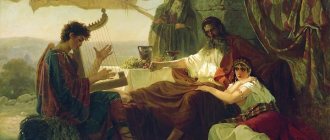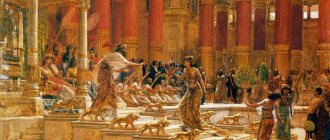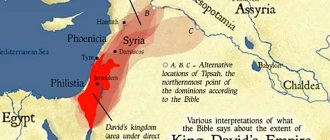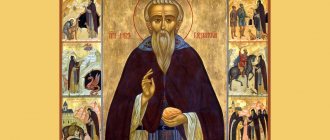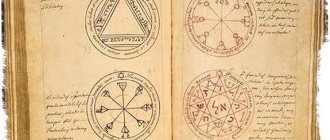The story from the Bible about David and Goliath is familiar today not only to believers. It became famous for its amazing plot: a shepherd defeats a huge soldier with a sling, relying only on God's help. Scientists have found evidence that such a battle actually took place, but who the winner actually was - different hypotheses are put forward.
Goliath is a character in the Bible.
Goliath is a biblical character. Described in the Bible as a Felistine giant warrior. In the classical Jewish tradition, Goliath's status as a representative of paganism was emphasized, in contrast to David, the chosen one of the God of Israel. Goliath was from Gath, one of the largest Philistine cities.
Ilya Repin. David and Goliath, 1915
The description of Goliath varies in various ancient manuscripts: the oldest manuscript books—the Dead Sea Scrolls, the 1st century text of the First Book of Kings, the 4th century Septuagint manuscript—all describe him as a tall man, standing 2.06 m tall, while the Masoretic text depicts him as a three-meter giant.
King of Israel
Soon Samuel's prediction began to come true. David and his people settled in Hebron, here he was declared king - so far only in the south of the land of Israel. In the north, the remaining son of Saul, Ishbosheth, ruled. But soon he was killed by traitors. Then David became king over all Israel. It is believed that this happened around 1005 BC.
Prophet David1727–1728. Moscow.96 × 40 cm. Wood, tempera. From the Peter and Paul Cathedral in St. Petersburg
Jerusalem - the new capital
One of the first acts of the king was the capture of the fortress of the Jebusite tribe around 1000 BC. She received a new name, now known to everyone - Jerusalem, which means “city of peace.” The king ordered the Ark of the Covenant, the main shrine of the Jews, to be brought here. Once it was captured by the Philistines, and later, struck by executions, they returned it back to the Jews. But the Ark remained in Kiriath-jearim.
Interesting fact
In Jerusalem, David built a tabernacle in the likeness of Moses. With a huge crowd of people, up to 70 thousand people, the Ark was brought into the city. Every six steps of the procession a sacrifice was made.
The king, throwing off his rich clothes, danced and rejoiced in front of the Ark in the linen clothes of a priest, praising God. Many did not understand David. Even the queen, Michal, was later indignant: this was not a royal matter. But David was not embarrassed:
Transfer of the Ark of the Covenant. Last third of the 18th century. Wood, tempera. 86.5 × 171.5 cm State Museum-Reserve “Kolomenskoye”, Moscow, Russia The image is reproduced from the publication: Komashko N. I. Russian icon of the 18th century. M.: Agey Tomesh, 2006.
Thus began the glorification of Jerusalem as a holy city, the house of God. But we owe David not only Jerusalem.
Liturgical tradition
It was David who instituted the first regular worship services. Subsequently, when Solomon built the Temple, this tradition would form the basis of the Temple's worship. Then its individual elements will be borrowed by Christians. Among David's innovations:
- division of the Levite priests into orders, each of which performed divine services at a certain time
- creation of choirs for liturgical singing
- selection of musicians to play musical instruments during worship
- creation of a hymnographic tradition
The names of the musicians who created the chants are known: Asaph, Yeman, Evad.
But the main creator of liturgical hymns was David himself. His chants, with which the king once consoled himself in exile, poured out grief over losses, joy of victories - apparently, then they began to combine them into a book now called the Psalter, named after the king’s favorite musical instrument.
David and Bathsheba
David's reign was glorious: Moab, part of Syria, and Idumea were conquered, and the king won many victories over the Ammonites. But it was at the height of his glory and power that David succumbed to temptation
His attention was attracted by a woman whom he accidentally saw from the roof of the palace. Although, according to Eastern tradition, the king had many wives and concubines, he suddenly wanted this one
We advise you to study What to do if your soul hurts: from exact causes to treatment methods
Although Bathsheba - that was her name - was married to one of David's best military leaders, Uriah.
But this did not stop the king. However, Jewish authors assure that what the king did was not lawlessness in the strict sense: husbands, going on a military campaign, handed their wives a so-called letter of divorce, which made the woman free. Uriah did the same. But when the woman turned out to be pregnant, Davil committed a really serious sin, sending Uriah to the war in the most dangerous place. So he was said to have killed his opponent with the sword of the Ammonites. It was for this sin that the prophet Nathan sharply rebuked David.
Prophet Nathan denounces David. Parisian hymnal
A psalm now known to every Christian is dedicated to this fall:
“Have mercy on me, O God, according to Your great mercy...”
With tears of repentance, David tried to appease the Lord and avert righteous judgment - not from himself, but from the child born of Bathsheba. But the boy did not survive. David accepted the righteous judgment with humility. Subsequently, the legitimate wife Bathsheba will give birth to King Solomon, the most glorious king of Israel.
But David bore retribution for his sin for a very long time. Soon conflicts arose in the royal family.
David vs Goliath
The confrontation between David and Goliath is described in chapter 17 of the First Book of Samuel. Saul and the Israelites encountered the Philistines in the Valley of Elah. For 40 days, Goliath, the mighty Philistine warrior, came out morning and evening and invited someone to fight him one on one and decide the outcome of the battle. However, there was not a single brave man among Saul's soldiers.
One day, the shepherd boy David, who was bringing food to his warrior brothers, heard Goliath's call to battle and volunteered to confront Goliath.
And David said to Saul: Let no one lose heart because of him; your servant will go and fight with this Philistine.
Saul gave David his armor and sword, but David refused because he was not used to such clothing and weapons. David armed himself with only a stick and stones.
Before the battle, David said to Goliath:
...you come against me with sword and spear and shield, and I come against you in the name of the Lord of Hosts...
David released a stone from his sling and struck Goliath hard in the forehead. Goliath fell face down on the ground, and David cut off his head with his own sword. The Philistines fled after the death of Goliath. The Israelites pursued the Philistines all the way to Gath. David with Goliath's severed head returned to King Saul's tent.
Swift Stones
In response to this statement, Israeli experts began to study stones that could be used for sling throwing. Several countries conducted interesting experiments to measure the speed and impact force of those same stones launched from a sling. Alan Uigbart and Ron Compson, ballistics experts from Glasgow, used a high-speed video camera and were amazed to find that stones fired from a sling reached speeds exceeding 100 kilometers per hour. Experiments in other countries confirmed that these stones could easily pierce a person’s soft tissue and break his bones.
It has now been proven that the seemingly incredible episode from the Bible no longer raises the slightest doubt.
Interpretation of the story of David and Goliath
The main purpose of the story of David and Goliath is to show the people that Saul cannot be the king of Israel. We know that Saul, like Goliath, was tall and head taller than anyone else in all Israel, and he was the clear contender to defend the honor of his people in a duel with Goliath. However, Saul did not find the courage to do this.
The Christian tradition views the battle of David with Goliath as a symbol of the victory of God's king over the enemies of God and as a prototype of the future victory of Jesus over sin and the Church over Satan.
The story of David and Goliath shows how the Lord protects His people. David, filled with faith and love for God, whose name was blasphemed by Goliath, killed Goliath with almost his bare hands.
The phrase “David and Goliath” or “David versus Goliath” has long become a household word and is used in relation to a situation where a weak opponent faces a much stronger one.
Introduction.
The monarchical form of government is one of the oldest. It provides for hereditary (less often, elective) autocracy, sanctified by religious sanction. According to a number of researchers, the roots of monarchical ideas go back to the prehistoric past, when supernatural properties were attributed to magician leaders. The influence of magic on the idea of monarchy continued in the states of the Ancient East. Thus, the Egyptians believed that the pharaoh, with his inherent power, maintained the stability of the natural order. They looked at him as a physical descendant of the gods. In Mesopotamia, the beginning of the deification of kings is associated with the name of Naram-sin (Naram-Suen), who lived in 3 thousand BC. The idea of the divinity of the king came to the ancient world from the East and, after Alexander the Great, took hold in the Hellenistic powers. In Rome, the deification of the Caesars began with Augustus. The monarchical principle placed the autocrat above the law, making him the living personification of “divine law.” For almost a thousand years, the Old Testament community did not know a monarchy and was ruled by the heads of the Israelite tribes and clans, and later, starting with Moses, also by charismatic leaders. Their right was based on the special mission and influence of the Spirit of God (Judges 15:14–15). Theocracy was considered the ideal of government in Amphictyony: only the Lord was recognized as the true Ruler of the people. Therefore, Gideon demonstratively renounced royal power (Judges 8:22 - 23), and his son's attempt to become a monarch caused resistance (Judges 9:22 - 23). Society was prepared for the idea of the need to establish a monarchy by the disasters of the Philistine yoke (11th century BC). Nevertheless, the idea of theocracy has not lost its force. The Holy Scripture clearly shows an ambivalent attitude towards monarchical power. On the one hand, it is recognized as a political necessity (in view of the fight against external enemies); but on the other hand, the ideal remains a free union of tribes, built on theocracy, that is, on the subordination of all to the will of God, expressed through the prophets. This second approach defines the negative attitude towards kingship that dominates the Bible.
Operation Research
What's so interesting about Operation Horse is that despite the terrible conditions, strong polar winds, lack of sunlight and the real risk of becoming polar bear food, the crew did not take the mission so badly.
On the European mainland, Germany was quickly pushed beyond its own borders. The Germans suffered heavy losses and towards the end of April, on the 30th, Adolf Hitler committed suicide in his bunker in Berlin.
It was at this time that the German Luftwaffe sent a telegram to the Spitsbergen unit with a message about the possibility of landing the plane near the weather station. The unit quickly built a makeshift airstrip. They packed up and were ready to leave Spitsbergen, but several days passed without any news: “no sound of planes,” as Wilhelm Dege wrote in his book “Gefangen im arktischen Ais”, recalling the Spitsbergen Operation.
Instead, they heard a message on the radio about Germany's surrender.
Tsar's squire
Yes, the existence of David has been proven, but the description of his duel with Goliath was still perceived by most scientists as fiction. Moreover, at the time described, David was not even a warrior yet, but was just the king’s squire. And so scientists set out to resolve this issue both from the point of view of logic and from the point of view of historical reality.
To begin with, it was necessary to find out whether a duel between representatives of two enemy armies could have taken place before the big battle? Scientists answered this question quickly. Yes, in various documents of that time evidence was found that such fights were not uncommon. The victory of a comrade in arms gave his comrades confidence in their abilities. And in this case, the victory of David over Goliath began the offensive of the Israeli troops, who expelled the Philistines from their land.
But the Bible says that young David, a former shepherd, was just the king’s armor-bearer! How could he then cope with an adult warrior?
We advise you to study Prayers to get pregnant
“It’s very simple,” Australian historian Patrick Trickett dispelled doubts. “The honorary position of the king’s squire could then be awarded only to those who showed themselves heroically in battle.”
Then another question arose: how was David, who refused armor, with just a sling in his hands, able to cope with the huge Goliath, who, as the Bible says, was well armed?
Foreign policy
David expanded his territorial possessions, taking lands from neighboring states. He conquered the historical region in western Jordan, defeated the Arameans in Syria, and annexed Idumea. In addition, the king discovered treasures of copper and entered into business cooperation with the Phoenicians, who were known as experienced traders.
Kingdom of Israel under David's reign
The Phoenicians bought cereals and livestock from David, paying by barter. In return, the king received wood and advanced technologies: David’s companions brought writing and the alphabet they invented to the state, which was later borrowed by the Jews.
Young anointed of God
According to the Old Testament, the pious Bethlehemite Jesse and his Moabite wife Ruth, who lived in the 11th century BC. e., eight sons were growing up, the youngest of whom was the future biblical king David. It is generally accepted that he was born in 1035 BC. e.
The Holy Scripture tells that even in his youth the boy was distinguished not only by his beauty and strength, but by his amazing eloquence, as well as his ability to play the kinor, an ancient stringed instrument.
The life, or, more simply, the biography of King David, begins with the fact that he appears before the readers as a young shepherd, spending days and nights with flocks of sheep on the slopes of the hills surrounding his hometown of Bethlehem. The young man was distinguished by his courage, protecting his charges from bears and lions.
We advise you to study Prayers for work to Saint Tryphon
In those years, the people of Israel were ruled by King Saul, who became the first anointed of God, but was then rejected by Him for rebellion and pride. Therefore, the Lord sent the prophet Samuel to secretly anoint His new chosen one to reign, who became the young shepherd ─ the youngest son of the Bethlehemite Jesse. From the moment the prophet fulfilled this great mission, the Spirit of God rested on the future King David, and he became the executor of His holy will.
Forgotten detachment of the Wehrmacht
The men want to return to Germany, see what is left, and help rebuild the country. The only option available to them to return to Germany was to establish radio contact with the Allies.
If the unit made contact with the Allied powers, it would mean that they would be arrested as prisoners of war and potentially face long prison sentences.
Wilhelm Dege tried to remain optimistic:
A month or two later, the unit noticed another change. The Norwegians returned to the weather station in Tromsø. Although the detachment tried to establish radio contact with them, it was almost impossible.
There were no ships or planes on the horizon.
In August, Dege's detachment received a radio message from the Norwegians. They realized that the Germans were stuck on the island and would send a mission to pick them up.
At the beginning of September, one ship after another was going to Spitsbergen. At this point, almost 4 months had passed since the official end of the war in Europe. On the night of September 3, a seal hunting vessel moored near the weather station.
Years of persecution
From that moment on, open persecution of the chosen one began. It was forbidden to take it in Israeli cities under penalty of death. Michal was given in marriage to someone else. God sent a message to the chosen one through the prophet Gad, and he took refuge in a mountainous area near Bethlehem. Other people, offended by the ruler, began to join him. Soon a small detachment of warriors gathered.
The king and his army continued to pursue him. It so happened that Saul entered the very cave in which David was hiding. The chosen one had the opportunity to kill his persecutor, but he only cut off the edge of his robe. When the master came out of the cave, David showed him a piece of cloth as proof that he had not taken advantage of the opportunity to kill. The young man asked for reconciliation and assured that there was no evil in his plans. At first this impressed the persecutor, and he temporarily left the saint alone.
The peaceful mood did not last long. After some time, he again moved at the head of the army against the anointed one.
And again a similar incident occurred - David managed to sneak into the tent where Saul was sleeping unnoticed and take his spear. Then he came out and showed the spear from afar. This nobility again impressed the persecutor, and he left.
Iconography
On the icons, the king and prophet David are depicted wearing royal robes and a crown. In his hand is a scroll with the words of the psalm. Prophecies from the Psalter concerning the Birth of the Messiah and the Mother who gave birth to Him are especially often written on scrolls. After all, the Mother of God comes from the line of David: “Hear, O Daughters, and see... and forget the house of Thy father...”, “Rise, O Lord, into Thy rest, Thou and the ark of Thy holiness...”
“Remember, O Lord, David, and all his meekness...” These are the words of the psalmist, repeated by believers even now. They seem to say: we are sinners, Lord, but here lived a saint among us - who retained love for people and for God, despite all the temptations. And we also fall, but we get up, we sin, but we remain children of the Lord. And since the righteous live among us, it means there is hope, there is repentance.
Natalia Sazonova
